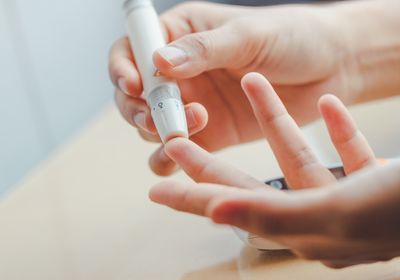ABOVE: Common blood glucose monitoring methods require patients to use lancets to draw blood. ©iStock.com, Ta Nu
For people with diabetes, blood sugar monitoring is a daily — and sometimes hourly — chore. Most approaches are invasive and involve piercing the skin, which can cause pain.
Now, researchers at Yonsei University in Korea have developed a wearable patch that emits fluorescence based on the wearer’s blood sugar levels. In a study recently published in Science Advances, researchers revealed a thin, invisible, and biodegradable patch that successfully measured different concentrations of blood glucose in mice.1
The researchers speculated that when combined with a smartphone application, the technology could help patients with diabetes continuously and noninvasively monitor their blood glucose levels.
Many people with diabetes monitor their blood sugar with a standard glucose meter. They prick their fingertips with a hairlike needle, or lancet, to draw minuscule amounts of blood. If done incorrectly, this process can be painful and cause hard calluses. Other common alternatives are also invasive.2
See "Diabetes Marker Linked to COVID-19 Severity in Mice"
Ki Jun Yu, an electrical engineer at Yonsei University and coauthor of the study, set out to tackle the current problems in diabetes monitoring technology by developing “a minimally invasive glucose monitoring sensor capable of recording glucose in a reliable and continuous manner.” He and his team also set out to make the sensor biodegradable, so patients wouldn’t have to worry about removing it. The sensor degrades completely roughly every three days.
The sensor the researchers designed consists of two layers. The top layer is made from polyvinyl alcohol. The second layer comprises an array of needles which pierce the skin surface but not far enough to reach nerve endings. This layer is made of silk, a well known biodegradable material.3
To measure glucose, the team chose a glucose fluorescent (GF) monomer composed of two parts. The first is a di-boronic acid, which binds to glucose in the interstitial fluid just underneath the skin. The other is a hydrophobic fluorescent molecule, which changes shape and emits fluorescence when glucose binds to the acid. When glucose binds to the GF monomer, the monomer absorbs blue light and emits red light.
To test the sensor accuracy, the researchers implanted it onto the skin of a hairless diabetic mouse. They shone light onto the patch and collected its fluorescence using a camera while they intravenously injected the mouse with a glucose solution.
The patch could potentially be worn on any part of the body, said Yu. Whenever wearers want to measure glucose levels, they could shine a smartphone’s flashlight onto the patch. Then, they could use an app that leverages the phone’s camera feature to measure the fluorescent intensity emitted from the sensor and translate to blood glucose levels. This is conjecture at this point since the researchers did not test any of these predictions in the study.
See "An Implantable Device for Type 1 Diabetes Treatment"
“The system could completely replace the conventional blood glucose measurement method such as lancet approaches so that patients with diabetes can conveniently prevent hypoglycemia and hyperglycemia,” Yu said.
According to Gregory Forlenza, a pediatric endocrinologist at the University of Colorado School of Medicine who was not involved in the study, the technology is a novel proof of concept, but it may not be exactly what patients are looking for. Forlenza does research with Medtronic and Dexcom, which both manufacture blood glucose monitoring systems. “The idea that young adults would be taking pictures of their own sensor array in school or in a restaurant in front of their friends—I don’t think people are going to want to do that,” he explained.
The authors should consider doing more tests that quantify the sensor’s sensitivity at low blood glucose levels, which are especially dangerous for patients, Forlenza added.
A potentially more powerful application of the technology would be to use it in tandem with an insulin-delivery device, such as an insulin pump, Forlenza said.
Yu agreed that there are several steps and design considerations that need to be made before the sensor is ready for human use, but he remains optimistic that the technology will help patients with diabetes in the future.
References
- Sang M, et al. Fluorescent-based biodegradable microneedle sensor array for tether-free continuous glucose monitoring with smartphone application. Sci Adv. 2023;9(22):eadh1765.
- Mian Z, et al. Continuous glucose monitoring: review of an innovation in diabetes management. Am J Med Sci. 2019;358(5):332-339.
- Wöltje M, Böbel M. Natural biodegradable medical polymers. In: Science and Principles of Biodegradable and Bioresorbable Medical Polymers. Elsevier; 2017:351-376.
- Shibata H, et al. Injectable hydrogel microbeads for fluorescence-based in vivo continuous glucose monitoring. Proc Natl Acad Sci USA. 2010;107(42):17894-17898.







